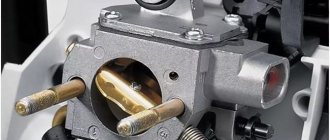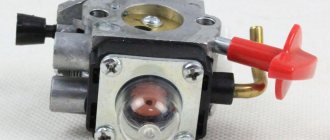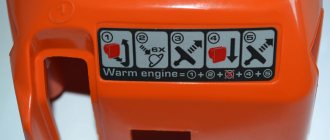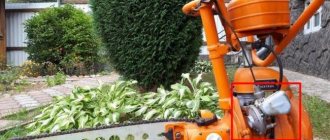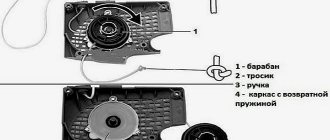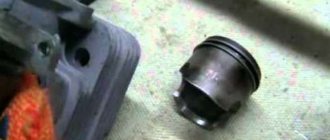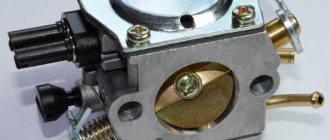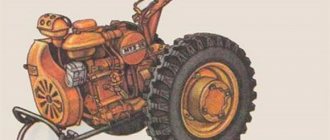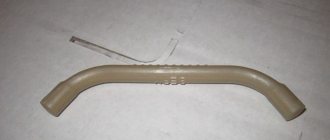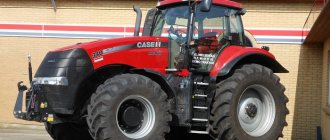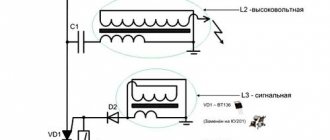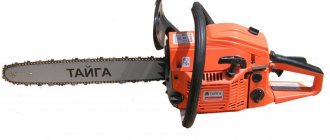Many people know how a two-stroke engine carburetor works on tools such as chainsaws, brush cutters and gas generators. However, this knowledge is only generalized, and when the need arises to repair or adjust the carburetor, a bunch of questions immediately arise, the answers to which you can find yourself if you thoroughly understand what the principle of operation of a chainsaw carburetor is based on. This is exactly what you have to figure out how the carburetor of different brands of chainsaws works.
Why is a chainsaw carburetor called a membrane carburetor?
Before you begin to consider the principle of operation of a chainsaw carburetor, you need to understand why they are called membrane ones. Membrane carburetor (membrane carburetor) is an improved model that can operate in any position. This is very important, since chainsaws, like lawn mowers, are operated in more than one position. Therefore, membrane carburetors are able to operate in any position, which is their main difference from devices of an outdated design or old design.
If the new model carburetor uses a membrane, then the old model models, which are used on a chainsaw such as Druzhba, have a float chamber. It is in the float chamber that the accumulation of gasoline of the appropriate volume occurs. When the float moves down when gasoline is used up (the chamber is empty), the needle moves along with the float, which opens the fuel supply hole into the float chamber.
At the same time, normal operation of the old-style carburetor is ensured under one simple condition - it must be in the appropriate position. When the device is moved to the side by 90 degrees or more, the float will move, and therefore the needle will block the fuel supply holes. This is why old-style chainsaws are designed only for use in one position. The unit itself is in one position, and depending on the type of work performed (cutting a tree or sawing a log), the position of the tire is adjusted.
Knowing how the Druzhba chainsaw works, you can begin to consider the principle of operation of the carburetor of modern units that do not have a mechanism for moving the tire (changing the angle of its position).
What does a chainsaw carburetor consist of?
The units of modern chainsaws under consideration differ in design from old-style devices. Moreover, this difference lies not only in the design, but also in the principle of operation. But first things first. First, we will learn the main components of the mechanism, and then we will understand the principle of operation of a chainsaw carburetor.
Structurally, a chainsaw carburetor can be divided into three parts:
- Fuel suction chamber from the gas tank. This chamber is connected not only to the gas tank via a fuel line, but also to the design of the crank mechanism. This part consists of two fittings, a membrane for pumping fuel, two valves, a filter and a transport channel
- A chamber for accumulating the fuel mixture and delivering it to the idle, medium speed and maximum speed channels. This chamber consists of a needle or needle valve, a membrane for opening the needle, a fuel accumulation chamber, adjusting screws, a maximum speed damper, as well as the XX and medium speed channels, which are always open
- The working zone is the main area in which air and fuel are mixed and this mixture enters the combustion chamber. The main working elements of the working area include dampers (air and throttle), as well as a diffuser, in which mixing of fuel and air occurs
Setting up a chainsaw step by step
Here we will show you step by step how to adjust a chainsaw carburetor. As a rule, during normal operation, a complete carburetor adjustment is not necessary.
Sometimes it is necessary to adjust the T screw for stable idle operation. By rotating the screw clockwise, we increase the speed, and by turning it counterclockwise, we decrease it.
It is necessary to achieve stable operation of the engine, but in such a way that the centrifugal clutch does not engage at idle, that is, the chain remains stationary.
If, however, complete adjustment is necessary, then proceed as follows: with the engine turned off, tighten both screws L and H clockwise until they stop. Then turn it one and a half turns to the left. This is the standard position.
Then we start the saw and check how it reacts to adding gas. If the reaction is sluggish, unscrew screw L a little more, but no more than 1/8 of a turn.
Screw H sets the maximum engine speed. They are usually indicated in the instructions. To adjust, you must have a speed meter - a tachometer. There are methods for adjusting speed without a tachometer by ear. We do not exclude this method, but we do not recommend it either. If these adjustments do not produce results, we look for the reason.
How does a carburetor work on a chainsaw? Let’s figure out how to supply fuel to the device
So, the device in question on a modern chainsaw has a simple operating principle, which is based on vacuum. Probably, when repairing a chainsaw, more than once every sawyer asked himself the question why there is no fuel pump on the unit. On such a small unit there is simply no place to install a pump, and its function of supplying fuel is performed by the carburetor itself. To understand how a chainsaw carburetor works, let’s first consider the features of fuel supply to the mechanism.
This is interesting!
Let's return to our Druzhba chainsaw, in which the gas tank is located above the engine.
This design was made for a reason. Indeed, in the design of old chainsaws there is also no fuel pump; only its role is played by the location of the gas tank above the carburetor and the engine as a whole. Fuel enters the carburetor by gravity through the fuel line, and its excess is eliminated due to the operating principle of the float chamber, as mentioned above. How is fuel supplied in modern chainsaws with diaphragm carburetors? In modern chainsaws, fuel is supplied to the carburetor through a special membrane, which is indicated as number 4 in the diagram below.
In the diagram, this membrane is indicated as a dotted oval. Its movement occurs due to pressure rarefaction. A completely appropriate question arises about where this rarefaction comes from. Let us consider in detail why we will rely on the diagram below.
Fitting number 1 is connected to the gas tank, which is located below the level of the carburetor. According to the laws of physics, fuel cannot flow into the carburetor according to this scheme. It is for this purpose that the design of the device in question has fitting 2 (it can also be presented in the form of a hole, which depends on the model of the tool, but the principle of operation of the chainsaw carburetor is identical). Through fitting 2, pressure enters the carburetor, which is taken through a channel from the crank mechanism chamber. The diagram shows a black line.
From the crankshaft chamber to the carburetor chamber through fitting 2, there is an alternating supply of air under pressure, the cyclicity of which depends on the rotation speed of the tool’s crankshaft. That is why, before starting the chainsaw, you must initially make several movements with the starter (which drives the crankshaft) without ignition in order to pump gasoline into the combustion chamber, and only after that start.
When a pressure vacuum is created by membrane 4, valve 3 alternately opens and closes. Fuel flows through the carburetor chamber and is directed to the inlet valve number 5. Valve 5 opens depending on the pressure created, but not by the membrane, but by the fuel itself. Next, the fuel enters through the filter element number 6, and moves in a purified form to the needle. A further diagram of the operation of the chainsaw carburetor is described in the next section.
Initial adjustment and starting to use the saw
Most instruments come pre-configured by manufacturers.
During the running-in process, the correct operation is checked:
- When starting up for the first time, you need to ensure that the chainsaw operates in a gentle mode. A few hours after the start, it is recommended to cut small branches and trunks up to 10 cm thick.
- The chainsaw must start correctly, ensure a stable rotation speed of the sprocket and a smooth increase and decrease in power.
- Fuel consumption must correspond to the power used and in practice the saw should not go out, “sneeze”, smoke or run jerkily.
- There should be no extraneous knocks, pops or noises when the engine is running.
The following rules will help you stay safe:
- Mix gasoline and oil in accordance with the proportions specified by the manufacturers.
- Do not prepare the mixture in advance. The properties of gasoline and oil in a mixed state change over time. The exception is fuel for intensively used tools, however, even here the norm of 7 days should not be exceeded.
- Use oil designed for the chainsaw brand engine. A fuel mixture with a non-standard composition will damage it.
- When preparing the fuel mixture, take into account the influence of climatic conditions on the components.
The principle of operation of a carburetor on a two-stroke chainsaw engine
We continue to understand step by step the principle of operation of the carburetor of two-stroke chainsaw engines. Such knowledge will be useful not only for beginners, but also for those who want to repair, adjust or configure the carburetor themselves. It is also necessary to know the principle of operation in order to understand why certain defects occur in the operation of the tool.
So, the fuel passes through the filter element and reaches the needle, which is indicated as number 11 in the diagram below.
Now we have to understand the principle of operation of the second carburetor membrane, which is shown in the diagram at number 13. Under the membrane there is a protective plate with a hole through which air enters. The diagram below shows the movement of air.
Number 14 in the diagram shows the fuel in the carburetor chamber. However, it will not get into this chamber until needle 11 opens (moves down). To move the needle, membrane 13 is used, which is connected to the needle through a rocker arm. The spring mechanism near the rocker arm is designed to return the membrane 13 to its original position.
It is worth noting that the membrane is made of flexible material, so it bends under the influence of the rod from the rocker arm. To open the needle, the membrane must move upward, thereby acting on the rod, and through the rocker arm the needle will move to the lower position, which will entail the flow of fuel into the chamber.
To understand why membrane 13 bends or moves, due to which the needle opens to allow fuel to enter the chamber, you will also need to find out the features of air flow into the mechanism.
Required Tools
Husqvarna special screwdriver
The main tool for adjusting the carburetor of a Chinese chainsaw is a medium-sized slotted screwdriver (flat type). Some saws require special keys, for example to set up the Husqvarna.
For more accurate and faster tuning, a tachometer is still required; it allows you to determine the engine speed, but this is not our case, our task is to learn how to tune by ear.
Read more about what tachometers are available, where to buy, how much they cost, and also how to set up a chainsaw with it.
For reference! This is the same as tuning a guitar. An experienced musician tunes by ear, while a beginner tunes using special instruments. In the case of a chainsaw, the opposite is true. An experienced person adjusts it with a tachometer, and a beginner tunes it by ear. In our repair shop, we use a high-quality and inexpensive tachometer from Aliexpress, which can be purchased at this link.
Buy tachometer on Aliexpress
How a chainsaw carburetor works - features of air intake
The operating principle of a chainsaw carburetor also includes supplying an air mixture to the device. As you understand, not pure fuel (oil with gasoline) enters the combustion chamber, but a fuel mixture - oil with gasoline from the tank and air, which first passes through the filter element.
This is interesting!
The filter that is installed on the carburetor must be cleaned regularly, otherwise its clogging will reduce the flow of air into the system, which often causes the unit to malfunction.
Many inexperienced sawyers immediately start adjusting the carburetor, but it is enough to clean the filter and blow it with a compressor to eliminate the causes of uneven or unstable operation of the tool. So, the air passes through the filter and enters the device through membrane number 7.
During a cold start, air damper 7 is almost completely closed, as shown in the diagram. Through it, a small amount of air enters the system. Air enters diffuser 16. Number 12 indicates channels or jets for idle speed and medium speed. These channels are interdependent, that is, the medium speed channel is transitional from idle. These channels are constantly open, so fuel in the appropriate dosage enters the diffuser, where it mixes with air, heading towards the cylinder.
Number 15 indicates the maximum speed channel, which consists of a valve with a rubber base. Through this valve, fuel is supplied in one direction - into the diffuser chamber. Next, the throttle valve 8 enters the system, the movement of which depends on the force of pressing the gas of the unit. When starting, valve 8 is in a vertical position, so the chainsaw operates only on the fuel mixture coming from the XX channel. The amount of air in this case is insignificant, since damper 7 is also open by a few millimeters. When you pull the trigger of the tool, the damper is deflected by 10-15 degrees, as a result of which the fuel mixture is supplied from medium speed channel 12 in the diagram above.
When the sawyer starts sawing wood, the number of revolutions increases to maximum, so the damper moves at an angle of up to 90 degrees from its original position. There is an increase in the amount of fuel, which accelerates the combustion of the fuel mixture.
In order for chamber 14 to be filled with a fuel mixture of gasoline and oil, which enters through the channel closed by the needle, it is necessary to create a vacuum, due to which the membrane 13 will be drawn inward, thereby acting on the rod. A vacuum in chamber 14 is created when the starter handle is pulled when the crankshaft of the tool moves. The piston moves up and down when “blinking” or “poking” the starter handle, which provokes the creation of pressure inside chamber 14. As a result, the chamber is filled with fuel, which enters the diffuser through the corresponding channels, mixing with air and heading into the cylinder.
After the engine of the unit is started, the piston will begin to move under the influence of the burning mixture, so a vacuum is constantly formed in the chamber, which actually provokes the bending of plate 13, which acts on the needle valve through which fuel enters the main chamber of the chainsaw carburetor.
Actually, this is the principle of operation of a membrane-type chainsaw carburetor, the functioning of which does not depend in any way on the angle of its location. Knowing the design and operating principle of the unit, you can begin setting it up, cleaning it and adjusting it.
Frequent chainsaw malfunctions
| № | Symptoms of a problem | Possible reason | How to fix |
| Reasons related to fuel supply | |||
| 1 | Fuel is not supplied to the engine (with the spark plug removed, compression inside the cylinder is determined; when checking for sparks, it is observed) | There is no fuel in the tank or the tap is closed | Fill the tank with a mixture of gasoline and oil according to the instructions |
| 2 | The hole in the gas tank cap is clogged | The hole in the lid needs to be cleaned | |
| Problems starting the engine | |||
| 3 | The engine does not start, liquid appears in the exhaust system | Water got into the fuel | Drain the fuel completely and refill with a fresh mixture of gasoline and oil. Add ethyl alcohol to the fuel tank and stir. Water and alcohol dissolve mutually, so this option is possible with a small amount of water in the fuel system |
| 4 | The cylinder is overfilled with fuel | Remove the spark plug and check whether it is dry or wet. If the spark plug is wet, then turn off the tap for supplying the working mixture to the cylinder. By pulling the starting cable, clear the cylinder of any existing liquid. Clean the candle and dry it. Place the spark plug in place, open the tap, pump up fuel and start starting according to the instructions for the chainsaw | |
| 5 | Disruption in work | Remove the spark plug and check it for | |
| ignition systems | the presence of a gap and moisture on the surface. Clean the gap between the spark plug electrodes. Heat with a hair dryer or gas burner. Check the gap and adjust according to the manufacturer's recommendations. | ||
| 6 | Gasoline oil does not enter the cylinder | Clogged carburetor jets | Clean the carburetor |
| 7 | There is an air leak between the carburetor and the intake port | Replace the gasket and eliminate the gap | |
| 8 | The booster pump does not work. Fuel does not enter the carburetor. | Replace the membrane in the pump | |
| 9 | Fuel does not evaporate due to the presence of cold air outside | Starting at t < 25 °C is difficult, gasoline evaporates with great difficulty. It is recommended to warm up the saw and start the engine inside a warm room. | |
| 10 | Defects of the cylinder-piston group | Scoring on the cylinder surface | Replace the piston and cylinder; the work is performed at a service center. Self-replacement is also possible. New parts need to be purchased. |
| 11 | Piston ring destruction | Replace rings. The work is carried out by service centers. To replace it yourself, you need to purchase spare parts. | |
| Unstable engine operation during operation | |||
| 12 | The engine stalls when the throttle is opened | The mixture is too rich | Carburetor adjustment required |
| 13 | Lean mixture coming in | Carburetor adjustment required | |
| 13 | The engine gets very hot | Operation is carried out at high air temperatures. Long-term operation at high crankshaft speeds | Clean fins cooling. Allow the engine to cool down |
| 14 | High concentration of oil in the fuel composition | The exhaust mixture burns out | |
| 15 | The engine does not develop full power | Incomplete throttle opening | Carburetor adjustment required |
| 16 | Clogged intake or exhaust tract | It is necessary to remove the carburetor and muffler. Flushing, cleaning, carburetor adjustment may be required. Clean and flush the air cleaner | |
| 17 | Malfunction of the sparking system | Check the operation of the magneto, high voltage circuit and spark plugs | |
| 18 | Unexpected engine stop | Lack of oil in the fuel mixture | Prepare a mixture of the desired composition. The piston or connecting rod journal may become jammed. The problem is solved by completely replacing damaged parts |
| 19 | Formation of a gap between the carburetor and the engine when the device heats up | Check the gasket, tighten the mounting bolts or replace the gasket if necessary | |
| 20 | The spark plug is not tightly wrapped, air is leaking into the cylinder | When the surface of the motor heats up, the seal in the threaded connection between the spark plug and the engine decreases. Need to tighten the candle |
The principle of operation of a chainsaw carburetor - the purpose of the regulators
Returning to our diagram, it is worth mentioning what the adjusting screws are for.
The diagram shows that the screw on the right side 10 is intended for setting idle speed and medium speed. Screw 17 on the left side adjusts the fuel supply at high speeds. Details of carburetor adjustment are described in another material on this site.
Following the instructions for adjusting the carburetor of a chainsaw, it will not be difficult to carry out the corresponding manipulations correctly. If you want to adjust the chainsaw as accurately as possible, you will need to use a special tachometer. You can buy a tachometer for a chainsaw in a tool store or online, especially since its price is not as high as the cost of repairing a chainsaw carburetor.
A detailed step-by-step description of how a chainsaw carburetor works is described in detail in the video material.
Carburetor adjustment controls
In order for the engine to operate stably, it is necessary to maintain a certain ratio of gasoline and air in the fuel mixture . If there is not enough gasoline, the mixture will be lean and the engine will not achieve the required power. If there is too much gasoline, the mixture will be too rich, which is also bad.
A jet is used to adjust the ratio of air and gasoline. The jet is the same tube in the spray bottle. Only very thin. In addition, the cross-section is regulated by a conical needle, which covers the hole. By screwing the needle inward, we reduce the cross-section of the hole and, accordingly, the supply of gasoline to the mixture; by turning it out, we increase it.
The air-gasoline ratio is different at low and high speeds, so most carburetors have two jets and two adjusting screws - for low and high speeds. The low speed screw is usually designated by the letter L, from the English Low - “low”. The high speed screw is designated by the Latin letter H, from the English High - “high”.
The mixture supply is controlled by the throttle valve. The more the throttle is open, the higher the speed. At idle, the throttle is almost closed. If the throttle is completely closed, the engine will stall. The opening angle of the throttle at idle is controlled by a special screw, usually designated by the Latin letter T, from the English Throttle - throttle. Designations may vary from manufacturer to manufacturer, so read the instructions.
Actually, these three screws regulate the carburetor.
